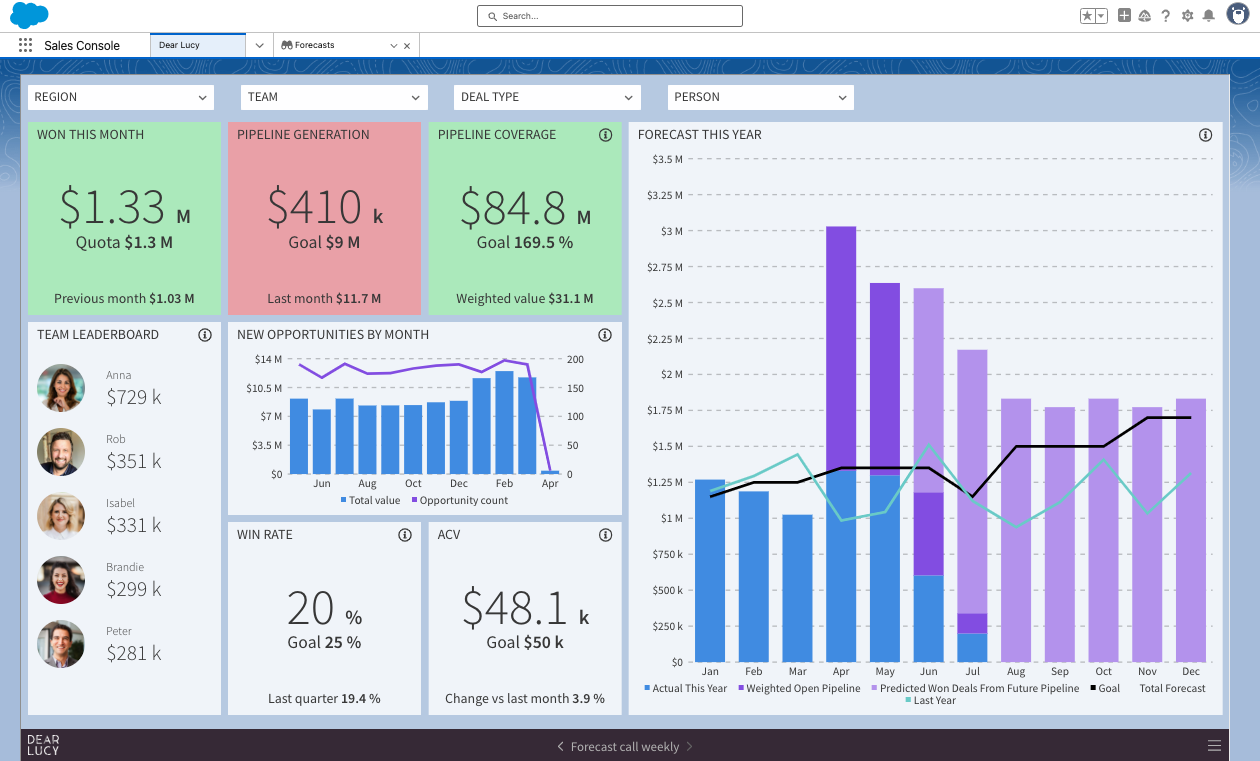Data-driven B2B sales leaders know that their teams can’t score if they don’t have a goal. Equally, they understand that high-level goals need to be broken down from revenue into pipeline and from pipeline down to activities, like meetings, calls, and emails.
Success comes from setting and tracking performance across all these levels, and across different parts of the sales organization—from territories and teams all the way down to individual reps.
In this blog post, we discuss what effective goal setting and tracking looks like in Salesforce, and how data-driven sales teams can overcome the limitations of Salesforce’s native goal and target tracking functionality with a dedicated Sales Performance Management platform like Dear Lucy.
Managing Goals in Salesforce
While some Salesforce versions allow you to create "goal" records that define targets for individuals or teams, it’s not a native feature in all Salesforce editions.
When available, each goal is typically linked to users or teams, time periods (like a month, quarter, or a year), and key metrics (like opportunities, leads, or activities).
However, Salesforce’s native goal setting and tracking features come with some serious drawbacks. Next up, let’s quickly walk through the most common complaints we’ve heard from our customers about Salesforce’s target setting capabilities.
The Limitations of Goal Setting in Salesforce
Target setting is not automatically available for all Salesforce users. Even when it is, it often requires custom objects, fields, or third-party apps to get it to work in the way you want.
Some of the most common frustrations with Salesforce’s native goal setting capabilities include:
Lack of flexibility: Salesforce’s target setting features are extremely rigid, and depending on your Salesforce license, you’re only able to set goals for a limited number of objects—if any. Data-driven sales teams, on the other hand, need to be able to track various targets and goals at all levels of the organization and funnel, from win rates to sales cycles and from individual meeting targets to territory-wide revenue goals.
No real-time visibility into target attainment: Setting a target is one thing. But what really makes targets valuable is the ability to track attainment against those targets on a daily basis. Unfortunately, Salesforce doesn’t offer support for this use case. Similarly, it doesn’t allow you to compare your results to the same period in history without creating two separate reports.
Poor visualization options: Salesforce’s out-of-the-box visualization options for tracking target attainment leave a lot to be desired. For example, if you exceed your goals (which we sincerely hope you often do), the gauge chart will simply stop showing your progress past 100%.
Manual effort for complex goals: Complex goals (e.g., involving custom logic, multi-object tracking, or conditional progress) require custom development or automation via Flow/Apex.
No native support for aligning goals across teams: Salesforce struggles with more complex hierarchical reporting, where you need to easily view data in a tree-like or multi-level format.
For these reasons, sooner or later, most data-driven sales teams end up relying on a third-party Salesforce reporting tool for better target setting and tracking.
Setting Sales Goals and Targets with Salesforce and Dear Lucy
Dear Lucy is a sales reporting tool that allows you to embed advanced sales dashboards with sophisticated target tracking features directly into Salesforce.
Dear Lucy makes not only setting but also tracking sales goals easy. Whether you’re interested in setting meeting targets for each individual rep, tracking your whole team’s daily progress toward your revenue target, or anything in between, Dear Lucy can help.
Here are some of the reasons why our customers prefer goal setting and tracking with Dear Lucy.
Ease of Setup
Unlike Salesforce’s native reporting capabilities, Dear Lucy allows you to set targets in minutes. Simply choose the goal type you’d like to set and determine the target values for the chosen period.
Support for any type of goals or targets
With Dear Lucy, you can set targets for any sales or revenue metrics, whether it’s meetings, calls, sales cycle, win rates, pipeline, pipeline coverage, or revenue you’d like to track. By setting targets for both leading and lagging indicators—and for individuals, teams, territories, business units, and the whole organization—you’ll get the early warning signs you need to keep the machine humming.
Real-time visibility into target attainment
Speaking of early warning signs, Dear Lucy automatically calculates daily goal attainment for every single target you’ve set for your sales team to help you catch coaching opportunities early and course correct before it’s too late.
Advanced data visualization options
Dear Lucy uses visual indicators, like traffic lights, to show whether goals are on track (green) or behind (red) and allows you to customize what data is displayed and how. You can also combine any two corresponding time periods and/or targets against attainment in the same graph, as well as see your forecasts, targets, and actuals in the same graph.
Out-of-the-box support for complex target hierarchies
Unlike Salesforce, Dear Lucy allows you to manage complex goal structures within the platform. Simply start by setting the highest level goal and add dimensions like business units, territories, teams, or individuals to break the goal down throughout the sales organization.
In short, Dear Lucy offers flexible and fast goal management, which helps data-driven B2B sales organizations make better decisions in their daily work. Next, let’s take a look at how goal setting happens in practice with Dear Lucy.
How to Set Up Salesforce Goal Tracking with Dear Lucy
Connect Dear Lucy with Salesforce in one click.
Use the Dear Lucy interface to set targets for individuals, teams, territories, and/or the whole organization. You can set goals for any value, whether that’s related to revenue, pipeline, or activity.
Embed the dashboards you’d like to track into Salesforce in a few clicks.
When you’re done setting the targets you’d like to track and bringing the dashboards you want into Dear Lucy, you’ll gain immediate visibility into goal attainment at all levels of your sales organization.
This visibility allows everyone from the Board of Directors and the Management Team to the VP of Sales and from each Account Executive to every single BDR to track their target attainment in real time. Instead of spending time on pulling together status updates, everyone can focus on improving the leading indicators that will determine their success at the end of the reporting period.
Start setting and tracking better sales goals today
Sign up for your free 10-day trial of Dear Lucy today and see how easy target setting and tracking can be. No credit card needed.



